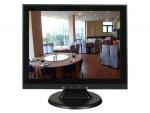Why do I need to become a member?
How do I become a member?
Send me straight to the membership form.
Video Hardware
Monitors

 Until IP cameras become feasible for webcasting, we are stuck with analog cameras. The ideal monitor for an analog camera is a CCTV monitor. While it is true that a television can serve as a CCTV monitor by using its 'video in' RCA connectors, the added complexity of having a remote and selecting the correct input has its own cost.
Until IP cameras become feasible for webcasting, we are stuck with analog cameras. The ideal monitor for an analog camera is a CCTV monitor. While it is true that a television can serve as a CCTV monitor by using its 'video in' RCA connectors, the added complexity of having a remote and selecting the correct input has its own cost.
Distribution Amplifiers

A distribution amplifier maintains image quality by isolating outputs from each other and maintaining proper impedance for each output. To see how to use one, you may want to look at this manual.
VCR/ DVD

Recording a service onto a physical media has two purposes. The first is to supply the homebound lacking access to the Internet. The second is to have a 'failsafe' for archiving the service on the website.
Homebound
Today, most homebound will be best served by VHS. In ten years this may not be true.
Switchers

A switcher switches back and forth between cameras. It can be either mechanical or electronic. The mechanical type is simply a switch, just like the push button switch on an old washing machine. The electronic type looks similar to the mechanical type, but does its switching electronically. The mechanical type is cheaper and tends to have transition glitches, like a moment of blue screen or a roll. The electronic type does a better job of switching for more money.
Pan/Tilt

For a webcast, you have to have one camera that moves called pan / tilt. The pan / tilt system is comprised of two components, the controller and the pan / tilt itself. These can be set up for prepositioning, like for the podiums. Prepositioning in a PELCO part number is represented by a PP. They also come in 360° panning models. This is represented by a SL (for slip ring). I don't recommend these because the camera video must be fed through slip rings just so you can go a full 360° instead of 355°.
Cameras

IP
The obvious solution for webcasting would seem to be IP cameras. (This kind of camera acts like a mini web server and sends the video through your router or switch either wired or wireless.) The problem is that these cameras tend to have very primitive software generally allowing only 11 fps into some kind of weird proprietory output format. Then comes the major problem of how to switch the output from 2+ of these cameras into 1 stream. You can't just use a mechanical switch to flip from camera to camera.
Media Server

Each client uses a specific amount of bandwidth when viewing a webcast. When the cumulative client bandwidth exceeds the upload bandwidth of the encoding computer's ISP, a media server must be used. In layman's terms, this means that if you want to reach more than 4 or 5 clients, you will need to send your webcast to a server which can then relay the webcast to your clients.
Baluns

Baluns are tiny transformers used when sending composite or component video over cat5 (twisted pair) cable. One is put on each end of the cable for 'balancing and impedance matching'. Though you would get an image if you did not use baluns, it would be much more susceptible to noise.
